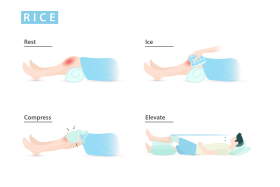
Back رايس (طب) Arabic RICE Czech PECH-Regel German Protocole GREC French RICE HE R.I.C.E. ID RICEの法則 Japanese RICE NB МЛКЕ (медицина) Serbian
| RICE | |
|---|---|
 Rest, Ice, Compression, and Elevation |
RICE is a mnemonic acronym for the four elements of a treatment regimen that was once recommended for soft tissue injuries: rest, ice, compression, and elevation.[1] It was considered a first-aid treatment rather than a cure and aimed to control inflammation.[2] It was thought that the reduction in pain and swelling that occurred as a result of decreased inflammation helped with healing.[1] The protocol was often used to treat sprains, strains, cuts, bruises, and other similar injuries.[3] Ice has been used for injuries since at least the 1960s, in a case where a 12-year-old boy needed to have a limb reattached. The limb was preserved before surgery by using ice. As news of the successful operation spread, the use of ice to treat acute injuries became common.[4]
The mnemonic was introduced by Dr. Gabe Mirkin in 1978.[5] He withdrew his support of this regimen in 2014 after learning of the role of inflammation in the healing process.[6] The implementation of RICE for soft tissue injuries as described by Dr. Mirkin is no longer recommended, as there is not enough research on the efficacy of RICE in the promotion of healing.[2] In fact, many components of the protocol have since been shown to impair or delay healing by inhibiting inflammation.[2][3][7] Early rehabilitation is now the recommendation to promote healing.[3][8] Ice, compression, and elevation may have roles in decreasing swelling and pain, but have not shown to help with healing an injury.[2][7][9]
There are different variations of the protocol, which may emphasize additional protective actions. However, these variations similarly lack sufficient evidence to be broadly recommended.[9] Examples include PRICE, POLICE, and PEACE & LOVE.[9][10][11][12]
- ^ a b "Sports Medicine Advisor 2005.4: RICE: Rest, Ice, Compression, and Elevation for Injuries". Archived from the original on 11 September 2007. Retrieved 15 August 2007.
- ^ a b c d van den Bekerom MP, Struijs PA, Blankevoort L, Welling L, van Dijk CN, Kerkhoffs GM (2012). "What is the evidence for rest, ice, compression, and elevation therapy in the treatment of ankle sprains in adults?". Journal of Athletic Training. 47 (4): 435–43. doi:10.4085/1062-6050-47.4.14. PMC 3396304. PMID 22889660.
- ^ a b c Bayer, Monika L.; Mackey, Abigail; Magnusson, S. Peter; Krogsgaard, Michael R.; Kjær, Michael (18 February 2019). "[Treatment of acute muscle injuries]". Ugeskrift for Laeger. 181 (8): V11180753. ISSN 1603-6824. PMID 30821238.
- ^ Wojciechowksi, Andrew. "Why You Shouldn't Ice An Injury – the RICE Method Myth". Correct Toes. Correct Toes. Retrieved 18 June 2023.
- ^ Mirkin, G. (1981). Sports-medicine book. Boston: Little, Brown. ISBN 978-0316574365.
- ^ Mirkin, Dr Gabe (16 September 2015). "Why Ice Delays Recovery | Dr. Gabe Mirkin on Health". Retrieved 5 December 2022.
- ^ a b Cite error: The named reference
:2was invoked but never defined (see the help page). - ^ Cite error: The named reference
:8was invoked but never defined (see the help page). - ^ a b c Cite error: The named reference
BJSMwas invoked but never defined (see the help page). - ^ Cite error: The named reference
pmid17137000was invoked but never defined (see the help page). - ^ Cite error: The named reference
pmid18093299was invoked but never defined (see the help page). - ^ Cite error: The named reference
:5was invoked but never defined (see the help page).